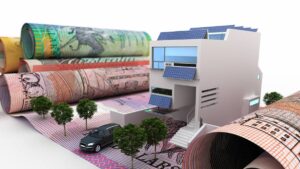Think Big: Is the world’s largest economy at risk of overheating?

Pic: Stevica Mrdja / EyeEm / EyeEm via Getty Images
As the global economy emerges from the pandemic, a key debate in economist circles centres around the pace of the recovery.
Record levels of fiscal and monetary support have been playing a crucial role in fending off a broader collapse.
But as central banks and governments stay committed to keeping the stimulus taps on while activity picks up, are developed economies at risk of running a little too hot?
In research this week, CBA senior economist Kim Munday addressed that query by assessing the US growth outlook.
“Many analysts are concerned that a perfect storm is brewing in the US,” Mundy said.
American authorities are executing on the vaccine rollout much more effectively than Europe and Australia.
And along with another $US1.9 trillion of COVID-19 stimulus in March (via the APR Act), the Biden administration is staying committed to plans for a huge push in infrastructure spending.
In combination, those factors have raised concerns that the rebound could morph into “an economic boom, overheat the US economy and cause inflation to rise strongly”, Mundy said.
But in measuring the effect of stimulus cheques, infra spending, the vaccine rollout and Federal Reserve policy, Mundy reckons those fears are a little bit overdone.
Will the US overheat?
$US1.9 trillion (of stimulus) would give the US economy a material jolt — if all of it was spent.
However, Mundy pointed to the response from US households to the last three government transfers in May 2008, April 2020 and January 2021.
In all three cases, the savings rate shot higher. So how much of their stimulus cheque does the average recipient actually spend?
Around one third of it, Mundy says, based on survey data from the Federal Reserve and Bank of America.
That equates to a spending boost of ~$US180bn, or around 0.9 per cent of GDP.
“This is not an insignificant boost to economic activity. However, it falls well short of headline estimates of the APR Act’s economic boost,” she said.
There’s also the matter of vaccine rollouts, where the US is on track to give 200m citizens a jab by the end of April.
Reduced health concerns = freedom of movement = a surge in pent-up demand, right? Mundy says not so fast.
Of note is the fact that many sectors which felt the brunt of COVID-19 were service sectors, such as restaurants.
She cited research from Princeton University, which says recoveries in service sectors are typically slower than goods sectors.
“Put simply, it’s hard to make up for all the restaurant meals, holidays and haircuts you didn’t have during lockdowns on top of what you can enjoy once restrictions are eased,” Mundy said.
And while the Biden administration’s $US2.25 trillion infrastructure plan is likely to boost GDP and create jobs, Mundy said it should be viewed in a long-term context.
The plan is for the infra package to be implemented over eight years. “More importantly, spending does not appear to be front-loaded,” Mundy said.
An average of $US280 billion per year over eight years is supportive, particularly for labour-intensive infrastructure projects.
But it’s not enough near-term sugar hit to warrant rate hikes before the end of 2022 (as some analysts have speculated), Mundy said.
Lastly, she assessed the US economic rebound in the context of monetary policy.
On that front, the US Fed is committed to its new policy stance in the wake of last year’s ‘seismic shift‘ towards how it views inflation with regard to the interest rates framework.
For now, the Fed still thinks the true rate of US unemployment is closer to 10 per cent, rather than the headline rate of six per cent, Mundy said.
And the bank has made it clear that once inflation does rise above two per cent, it won’t budge on rates.
“According to Chicago Fed President Charles Evans, it will take ‘months and months’ before high inflation readings are viewed as consistent with sustainably higher inflation,” Mundy said.
So ultimately, what’s implied there is that the Fed thinks the US economy is still has a way to go before it’s generating growth at a level that would warrant tighter monetary policy.
UNLOCK INSIGHTS
Discover the untold stories of emerging ASX stocks.
Daily news and expert analysis, it's free to subscribe.
By proceeding, you confirm you understand that we handle personal information in accordance with our Privacy Policy.








